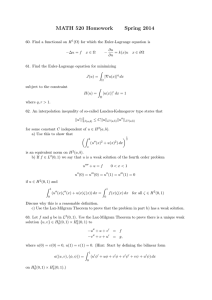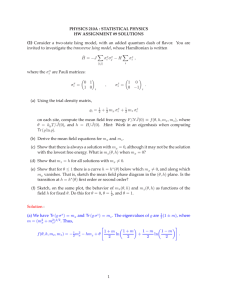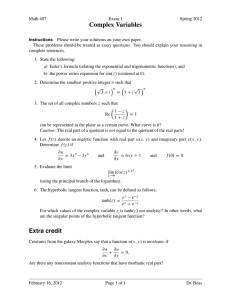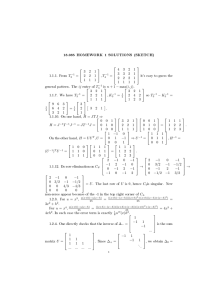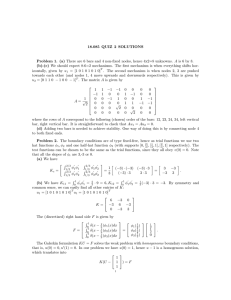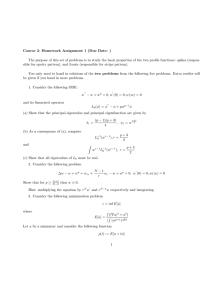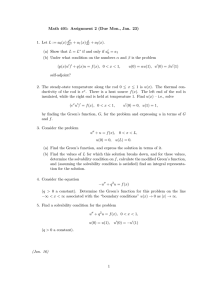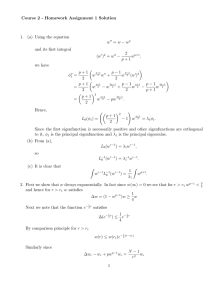Course 2 - Homework Assignment 3 Solution 1. (a) x Z
advertisement
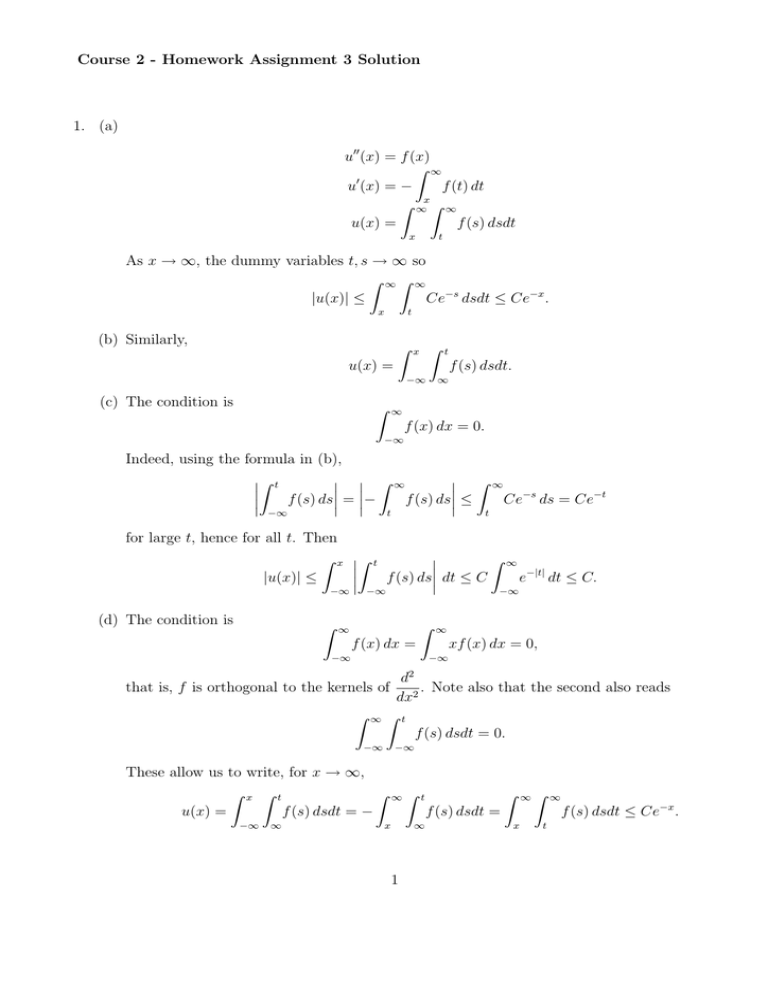
Course 2 - Homework Assignment 3 Solution 1. (a) u00 (x) = f (x) Z ∞ 0 u (x) = − f (t) dt x Z ∞Z ∞ u(x) = f (s) dsdt x t As x → ∞, the dummy variables t, s → ∞ so Z ∞Z ∞ |u(x)| ≤ Ce−s dsdt ≤ Ce−x . x t (b) Similarly, Z Z x t u(x) = f (s) dsdt. −∞ (c) The condition is Z ∞ ∞ f (x) dx = 0. −∞ Indeed, using the formula in (b), ¯Z t ¯ ¯ Z ¯ ¯ ¯ ¯ f (s) ds¯¯ = ¯¯− ¯ −∞ for large t, hence for all t. Then Z x |u(x)| ≤ −∞ (d) The condition is Z ¯Z ¯ ¯ ¯ t −∞ ∞ t ¯ Z ¯ f (s) ds¯¯ ≤ ∞ t ¯ Z ¯ ¯ f (s) ds¯ dt ≤ C Z ∞ Ce−s ds = Ce−t ∞ e−|t| dt ≤ C. −∞ ∞ f (x) dx = xf (x) dx = 0, −∞ −∞ d2 . Note also that the second also reads dx2 that is, f is orthogonal to the kernels of Z ∞ Z t f (s) dsdt = 0. −∞ −∞ These allow us to write, for x → ∞, Z x Z t Z u(x) = f (s) dsdt = − −∞ ∞ ∞ Z Z t ∞ Z ∞ f (s) dsdt = x ∞ 1 x t f (s) dsdt ≤ Ce−x . 2. (a) u0 (x) = −2 log cosh(x) + log 2 2 sinh(x) u00 (x) = − cosh(x) 2 u000 (x) = − = −eu0 (x) . cosh2 (x) (b) The translation invariance is clear, since the equation involves no x. For the scaling invariance, we see that (u0 (λx) + 2 log λ)00 + eu0 (λx)+2 log λ = λ2 u000 (λx) + λ2 eu0 (λx) = 0. (c) Applying − ∂ to (u0 (x − a))00 + eu0 (x−a) = 0, we have ∂a (u00 (x − a))00 + eu0 (x−a) u00 (x − a) = 0, that is, (u00 )00 + eu0 u00 = 0. The first kernel is φ1 = u00 (x) = − 2 sinh(x) = −2 tanh(x). cosh(x) The second one is given by ¯ ∂ ¯¯ φ2 (x) = (u00 (λx) + 2 log λ) = xu00 (x) + 2 = −2x tanh(x) + 2. ¯ ∂λ λ=1 (d) First we compute the Wronskian W = φ1 φ02 − φ01 φ2 = (u00 )2 − 2u000 = 4 sinh2 (x) + 4 = 4. cosh2 (x) By the variation of parameters formula, we have for any given a, b, Z x Z x φ2 (t)f (t) φ1 (t)f (t) φ(x) = −φ1 (x) dt + φ2 (x) dt W (t) W (t) a b Z x Z x = − tanh(x) (t tanh(t) + 1)f (t) dt + (x tanh(x) + 1) tanh(t)f (t) dt a b For decay at the positive end, we take a = b = ∞ to obtain Z ∞ Z φ(x) = tanh(x) (t tanh(t) + 1)f (t) dt − (x tanh(x) + 1) x ∞ tanh(t)f (t) dt. x (e) We require that f be orthogonal to the kernels φ1 and φ2 , that is, Z ∞ Z ∞ tanh(x)f (x) dx = (x tanh(x) + 1)f (x) dx = 0. −∞ −∞ In fact since φ2 (x) grows like x, the decay is a bit weaker: |φ(x)| ≤C(1 + |x|)e−|x| for all x. 2 3. If we define ã(r) = rN −1 a(r), then this is what has been discussed in the lectures. The necessary condition is (log ã)0 (r0 ) = 0 and a sufficient condition is the non-degeneracy (log ã)00 (r0 ) 6= 0. By direct computations, ã0 ã µ 0 ¶2 ã ã00 00 − (log ã) = ã ã 0 0 ã a N −1 = + ã a r 00 00 ã a 2(N − 1) a0 (N − 1)(N − 2) . = + + ã a r a r2 (log ã)0 = Therefore, the necessary condition is (log a)0 (r0 ) = − and a sufficient condition is (log a)00 (r0 ) 6= N −1 r0 N −1 . r02 4. (a) 8 = log 8 − 2 log(1 + r2 ) (1 + r2 )2 4r u00 (r) = − 1 + r2 4(r2 − 1) 00 u0 (r) = (1 + r2 )2 1 1 u000 + u00 + eu0 = (4r2 − 4 − 4 − 4r2 + 8) = 0. r (1 + r2 )2 u0 (r) = log (b) First note that the equation holds at λr: u000 (λr) + 1 0 u (λr) + eu(λr) = 0. λr 0 Then ¶ µ 1 0 1 u(λr) 0 u0 (λr)+2 log λ 2 00 = 0. = λ u0 (λr) + u0 (λr) + e (u0 (λr)+2 log λ) + (u0 (λr)+2 log λ) +e r λr 00 (c) A kernel is ¯ 2(1 − r2 ) ∂ ¯¯ 0 (u (λr) + 2 log λ) = ru (r) + 2 = . 0 0 ∂λ ¯λ=1 1 + r2 Let us take Z0 (r) = 3 1 − r2 . 1 + r2 (d) Let Z1 be the other kernel. By Abel’s formula, the Wronskian satisfies, up to a constant, W (r) = Z0 (r)Z10 (r) − Z00 (r)Z1 (r) = e− R 1 r 1 = . r Solving for Z1 (r) (reduction of order), we have Z r W (s) Z1 (r) = Z0 (r) ds Z02 (s) Z 1 − r2 r (1 + s2 )2 = ds 1 + r2 s(1 − s2 )2 µ ¶ 2 1 − r2 log r − 2 = 1 + r2 r −1 2 1−r 2 = log r + 2 1+r 1 + r2 By the variation of parameters formula, the solution satisfying 0 φ (0) = 0 is given by Z Z r Z1 (s)f (s) Z0 (s)f (s) φ(r) = AZ0 (r) − Z0 (r) ds + Z1 (r) ds W (s) W (s) 0 0 Z Z 1 − r2 r s((1 − s2 ) log s + 2) (1 − r2 ) log r + 2 r s(1 − s2 ) =− f (s) ds + f (s) ds. 1 + r2 0 1 + s2 1 + r2 1 + s2 0 r where A is an arbitrary constant. 5. Note that as r → ∞, Z0 (r) = −1 + O( , 1 ) r2 Z1 (r) = − log r + O( and Z r 0 log r ) r2 Z ∞ s((1 − s2 ) log s + 2) s((1 − s2 ) log s + 2) log r f (s) = f (s) + O( 2 ) 2 2 1+s 1+s r 0 Z Z r ∞ s(1 − s2 ) 1 f (s) = Z0 (s)f (s)sds + O( 2 ) 2 1+s r 0 0 Hence we have as r → +∞ Z Z ∞ φ(r) = A − ∞ Z1 (s)f (s)sds − log r 0 Z0 (s)f (s)sds + O( 0 Thus a necessary condition for φ to be bounded is that Z ∞ Z0 (s)f (s)sds = 0 0 4 log r ) r2 Under the above condition we can choose Z ∞ A= Z1 (s)f (s)sds 0 so that φ decays at +∞: φ = O( log r ) r2 Alternatively, we can define Z ∞ Z ∞ Z1 (s)f (s) Z0 (s)f (s) φ(r) = Z0 (r) ds − Z1 (r) ds W (s) W (s) r r Z Z 1 − r2 ∞ s((1 − s2 ) log s + 2) (1 − r2 ) log r + 2 ∞ s(1 − s2 ) = f (s) ds − f (s) ds, 1 + r2 r 1 + s2 1 + r2 1 + s2 r so for r large Z Z ∞ |φ(r)| ≤ ∞ s log s |f (s)| ds + log r r Z ∞ ≤2 s |f (s)| ds r s log s |f (s)| ds r Z ∞ s log s ds 1 + s4 Zr ∞ C log s ≤ ds r r s2 µ ¶ log r =O r2 ≤C However this definition (1) does not satisfy the initial condition 0 φ (0) = 0 unless R∞ 0 Z0 (s)f (s)sds = 0. In fact we calculate Z 1 ∞ 0 Z0 (s)f (s)sds φ (0) = lim r→0 r 0 5 (1)
